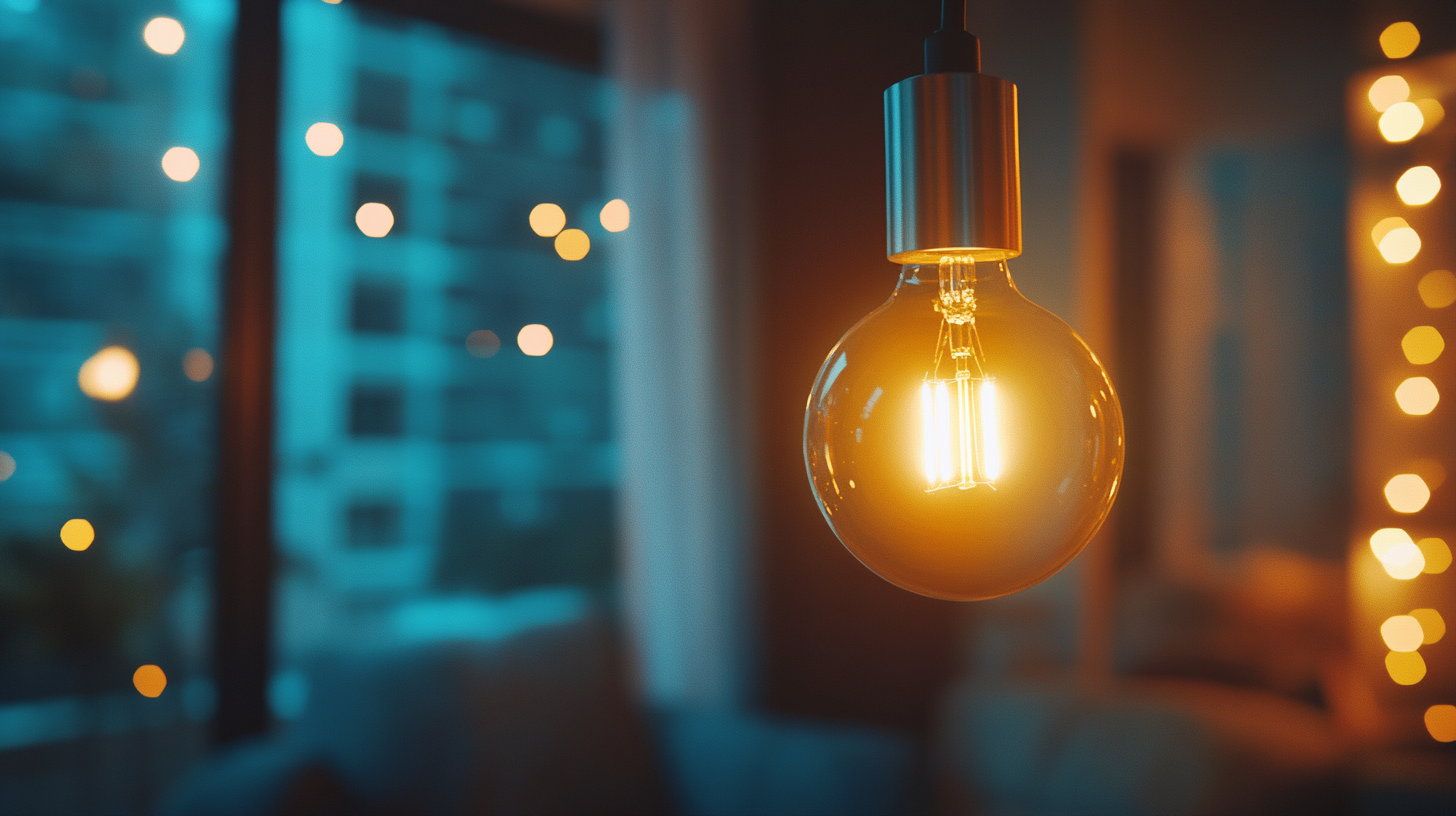Advantages of Choosing LED Bulbs for Smart Lighting Solutions
The rapid advancement in technology has significantly transformed the lighting industry, making LED bulbs a preferred choice for both residential and commercial applications. According to a report by the U.S. Department of Energy, LED lighting is projected to represent 75% of total lighting sales by 2030, highlighting a decisive shift towards more energy-efficient solutions. This important transition is largely due to the numerous advantages that LED bulbs offer, including longevity, energy savings, and versatility, making them an integral part of smart lighting solutions.
Moreover, the global smart lighting market is expected to reach $30 billion by 2025, propelled by the increasing adoption of LED technology. Research from Transparency Market Research indicates that LED bulbs not only consume up to 80% less energy than traditional incandescent bulbs but also possess a lifespan that is 25 times longer. This combination of efficiency and durability is essential for modern lighting solutions that demand both performance and sustainability. As consumers and businesses increasingly seek intelligent, eco-friendly lighting options, LED bulbs stand out as the optimal choice in the evolution of smart lighting solutions.

Benefits of Energy Efficiency with LED Smart Bulbs
The demand for energy-efficient lighting solutions has surged in recent years, with LED smart bulbs leading the charge. According to a report by the U.S. Department of Energy, LED bulbs present a remarkable opportunity for energy savings, consuming up to 75% less energy compared to traditional incandescent bulbs. This significant reduction not only helps lower electricity bills but also contributes to decreasing the carbon footprint associated with lighting. In addition to energy savings, LED smart bulbs boast longer lifespans, with many lasting over 25,000 hours. This longevity means that consumers can replace their light bulbs less frequently, resulting in reduced waste and fewer resources spent on manufacturing and disposal. A study published by the National Renewable Energy Laboratory found that if all U.S. households replaced one incandescent bulb with an LED, the energy savings could amount to nearly $600 million annually. The shift not only promotes sustainable living but also aligns with global efforts to reduce greenhouse gas emissions. Beyond efficiency, LED smart bulbs come with advanced functionalities like remote control, dimming capabilities, and integration with smart home systems. This technological innovation provides convenience and enhances the overall user experience. With features that allow customization of lighting based on mood or time of day, these bulbs also support energy-saving practices by allowing users to optimize their lighting usage more effectively. Consequently, they are an ideal choice for those looking to adopt smart lighting solutions that are both practical and environmentally responsible.

Enhanced Longevity: How LED Bulbs Outlast Traditional Lighting
LED bulbs are rapidly becoming the favored choice for smart lighting solutions, and one of the most significant advantages lies in their enhanced longevity. Unlike traditional incandescent or fluorescent bulbs, which typically last around 1,000 and 10,000 hours respectively, LED bulbs can shine for an impressive 25,000 to 50,000 hours or more. This extended lifespan not only means fewer replacements but also contributes to lower maintenance costs and less waste in landfills.
Industry reports, such as those from the U.S. Department of Energy, indicate that switching to LED lighting can lead to energy savings of up to 80%, mainly due to their efficiency and long-lasting nature. These bulbs convert a larger percentage of energy into light rather than heat, making them a much more sustainable option. Additionally, the longevity of LED bulbs supports smart home systems, where consistent and reliable lighting is essential. For instance, in automated settings, the ability to rely on lighting that doesn't frequently burn out ensures seamless operation and improves overall user experience.
Moreover, the durability of LED bulbs contributes to their efficiency in various environments. They are less susceptible to breakage compared to traditional bulbs and can perform well in extreme temperatures. Such resilience means that in places like outdoor fixtures or industrial settings, the reduced need for frequent replacements and repairs can lead to substantial cost savings in the long run. With all these factors in mind, it’s clear that LED bulbs offer unparalleled advantages for modern lighting solutions, particularly when it comes to longevity.

Smart Features: Integrating LED Bulbs into Your Smart Home
As smart homes continue to evolve, integrating LED bulbs into modern lighting solutions has become a pivotal aspect of enhancing living spaces. LED bulbs are not only energy-efficient but also feature advanced smart capabilities that allow users to control lighting remotely, schedule operations, and adjust brightness and color settings via smartphones or smart assistants. According to a recent report from Granview Research, the global smart lighting market is projected to reach $47.25 billion by 2027, with LED technology leading the way due to its long lifespan and energy-saving attributes.
In addition to basic functionality, smart LED bulbs often come equipped with connectivity options such as Wi-Fi or Bluetooth, allowing them to seamlessly integrate with various smart home ecosystems like Amazon Alexa, Google Assistant, and Apple HomeKit. This integration not only enhances convenience but also promotes energy conservation by allowing users to create customized lighting schedules that align with their daily routines. A study by the U.S. Department of Energy highlights that switching to LED smart lighting can reduce energy consumption for lighting by up to 75%, translating to significant cost savings over time.
Moreover, the ability to control lighting through voice commands or mobile apps offers users unprecedented flexibility. Smart LED bulbs can be programmed to mimic natural light patterns, promoting a healthier living environment. This adaptability is particularly useful for those who work from home, as personalized lighting setups can enhance focus and productivity. As the demand for smart home solutions grows, the advantages of LED bulbs solidify their role as an indispensable technology for creating intelligent, energy-efficient living spaces.

Cost Savings Over Time: LED Bulbs vs. Incandescent Alternatives
When considering lighting options, the shift from incandescent bulbs to LED technology brings significant cost savings over time, making LED bulbs an attractive choice for both homeowners and businesses. According to the U.S. Department of Energy, LED bulbs use at least 75% less energy than traditional incandescent bulbs and can last up to 25 times longer. This longevity means fewer replacements and decreased waste, contributing to both environmental benefits and monetary savings.
The initial investment in LED technology can seem higher, with average costs for LED bulbs ranging from $5 to $15, compared to incandescent bulbs which typically cost less than $1. However, these upfront costs are offset by the substantial energy savings. For instance, an LED bulb may consume about 10 watts of energy compared to the 60 watts required for an equivalent incandescent bulb. Given that the average household could save approximately $140 per year on energy bills by switching to LED lighting, the financial advantages quickly add up.
Furthermore, considering maintenance costs, LED lighting reduces the frequency of replacements often associated with incandescent bulbs. According to a report from the Lighting Research Center, an LED bulb can last up to 25,000 hours, while traditional bulbs only last around 1,000 hours. This extended lifespan minimizes labor and material costs related to changing bulbs, making LED solutions not only more efficient but also more economically viable in the long run.
Environmental Impact: Why LED Lighting is a Sustainable Choice
The environmental impact of lighting choices is a crucial consideration in today's world, especially as we face increasing challenges related to climate change and resource depletion. LED lighting has emerged as a sustainable choice that significantly reduces energy consumption and carbon emissions. According to the U.S. Department of Energy, LED bulbs use at least 75% less energy than incandescent bulbs and can last up to 25 times longer. This drastic reduction in energy usage translates into fewer power plants needed and significantly lower greenhouse gas emissions.
In addition to energy savings, LED lights contribute to waste reduction. Traditional incandescent and fluorescent bulbs have shorter lifespans, leading to frequent replacements and increased landfill waste. The National Renewable Energy Laboratory estimates that if every American switched to LED lighting, the U.S. would save $6 billion in energy costs annually, while also preventing the emission of 50 million metric tons of carbon dioxide. This impact demonstrates not only an economic advantage but also a significant step towards a more sustainable future.
Moreover, LEDs are free of toxic elements such as mercury, which is commonly found in fluorescent lighting. This characteristic makes them safer for both the environment and human health. As consumers increasingly prioritize sustainability, adopting LED lighting solutions becomes a logical and responsible choice. By transitioning to LED technology, individuals and businesses can play an essential role in reducing their carbon footprint and fostering a healthier planet for future generations.


